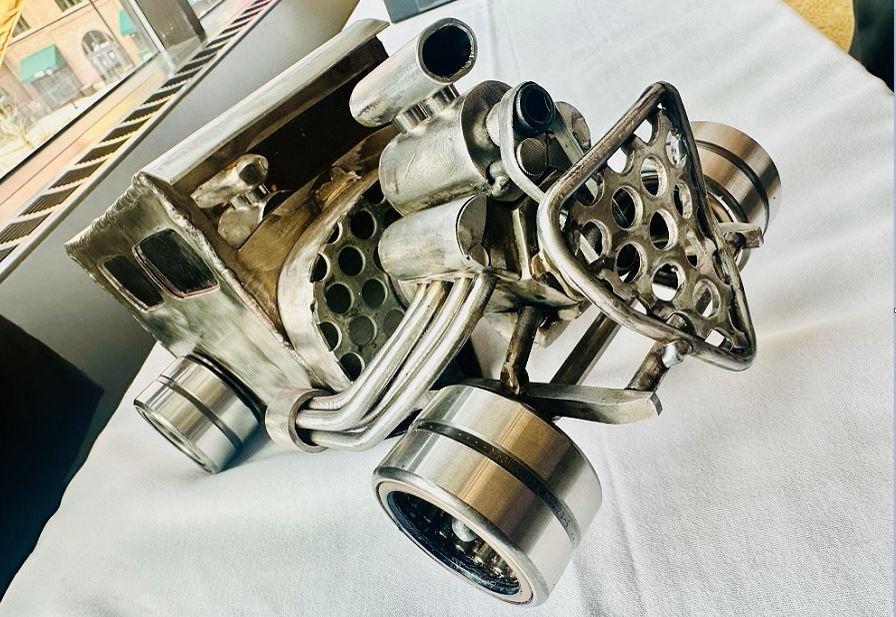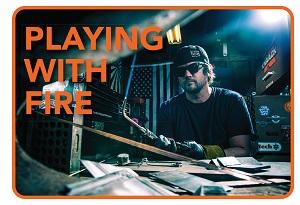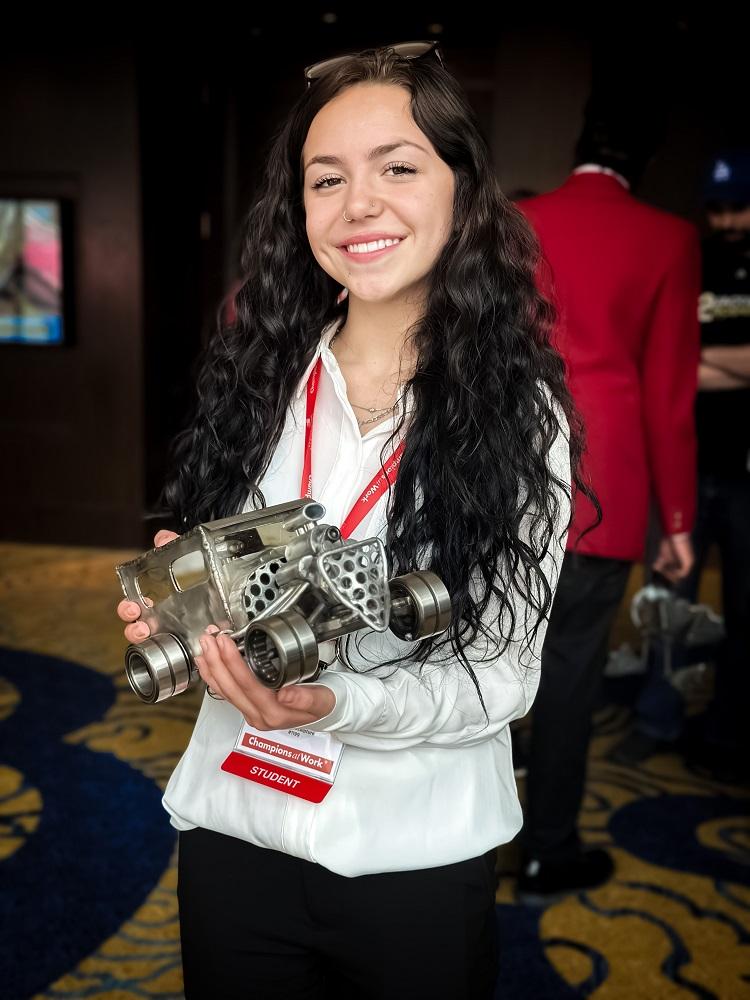Owner, Brown Dog Welding
- FMA
- The Fabricator
- FABTECH
- Canadian Metalworking
Categories
- Additive Manufacturing
- Aluminum Welding
- Arc Welding
- Assembly and Joining
- Automation and Robotics
- Bending and Forming
- Consumables
- Cutting and Weld Prep
- Electric Vehicles
- En Español
- Finishing
- Hydroforming
- Laser Cutting
- Laser Welding
- Machining
- Manufacturing Software
- Materials Handling
- Metals/Materials
- Oxyfuel Cutting
- Plasma Cutting
- Power Tools
- Punching and Other Holemaking
- Roll Forming
- Safety
- Sawing
- Shearing
- Shop Management
- Testing and Measuring
- Tube and Pipe Fabrication
- Tube and Pipe Production
- Waterjet Cutting
Industry Directory
Webcasts
Podcasts
FAB 40
Advertise
Subscribe
Account Login
Search
Playing With Fire: Judging Michigan’s first SkillsUSA welding sculpture competition
Growing awareness of the trades through metal art
- By Josh Welton
- Updated June 16, 2023
- June 12, 2023
- Article
- Arc Welding

Savannah Swafford’s sculpture paid homage to her favorite car growing up: her dad’s ‘28 Ford hot rod.
I recently volunteered as a judge for the first-ever SkillsUSA welding sculpture contest in the state of Michigan. And just by being around the competition that Saturday, I learned a lot about SkillsUSA, met some incredible kids, advisers, and judges, and thought about how we can grow the welding sculpture participation in the years to come.
Jeff Seelye has been pushing for a welding sculpture contest at the Michigan SkillsUSA State Leadership and Skills Conference for many years. He’s a retired General Motors tradesman, a former teacher at Lansing Community College, a CWI, artist, and a blacksmith. Jeff is extremely passionate about the trades, welding, and sculpture.
After years of running into a brick wall lobbying for a sculpture competition at the state level, he asked why they were so against the proposition. Their response: “Well, how would you find people to judge such a contest? And who will organize it?”
Say less.
Seelye took on the responsibility. And he already had in mind the first two people he wanted to bring aboard: yours truly and Caleb Brennan, the conservator and assistant curator of sculpture at Grand Rapids’ Frederik Meijer Gardens and Sculpture Park. Both of us said yes. My wife Darla, who shares a passion for art and promoting skilled trades, was also invited to judge.
We expected to have six to eight sculptors competing. But due to this being the first year and a few competitors dropping out last minute, we only had two sculpture entries.
Despite only having two sculptures to judge, Jeff remained overwhelmingly positive about the debut competition, which will lay the groundwork for years to come. He briefed us on his story regarding the fight for the contest and its mission and gave us some guidelines for basing our assessments. A misunderstanding about competition rules led to conversations that could inspire a future SkillsUSA category.
Both sculpture entries were great. Savannah Swafford’s sculpture followed the contest guidelines to a T. The St. Clair County Technical Education Center (TEC) student’s creation paid homage to her favorite car growing up: her dad’s ‘28 Ford hot rod. Her fabrication skills stood out. The mixture of textures in the metal displayed contrast, the illusion of motion was strong with the car positioned mid-wheelie, and the welds on the mostly stainless steel sculpture were outstanding. Even Swafford’s TIG welds—some of her first—showed significant skill and promise. With a father who builds hot rods and rat rods for a living, she wasn’t rushed to get limited time in the shop at school—her dad’s shop had all the tools she needed! Between her interview responses, the work, and the excellent binder documenting her step-by-step progress, Savannah nailed the vibe of the competition and won gold.
Then there was the Detroit trio of Gabriel Janke, Ivan Vidal-Garcia, and Shahveev Muhammad. Randolph Career and Technical Center welding instructor and student advisor Kevin Cartwright was so freaking excited about the SkillsUSA sculpture competition that he stopped reading the contest rules and told his students to start sculpting! However, in his understandable excitement, Cartwright missed some of the competition’s detailed rules: one student per sculpture, no painted steel, the piece must fit in an 18- by 12- by 18-in.-long box.
So, they showed up as a team of three (representing other students, too) with a 6-ft.-long black panther. The thing is, the sculpture was genuinely epic—the size, the proportions, and the illusion of movement were rad. They weren’t automatically disqualified, but the penalties for not following the guidelines were severe. The interview questions were meant for one person, but the boys seamlessly took turns answering for the group and speaking for themselves. The students learned to weld for this project and worked on the panther at different times during their morning or afternoon classes. Two students hadn’t even met until two days before the competition!
They had a time-lapse video of their process from start to finish, and their organizational skills were indeed on point. If you split the panther right down the middle, you’d never know that one class worked on the right side and the other worked on the left because the piece was so cohesive. When talking to the students, I noticed how they all complemented each other. They all displayed strengths and weaknesses and were self-aware, ultimately creating a solid team. The welding proved rudimentary, but they were receptive to constructive criticism and planned to improve. Ultimately, Mr. Cartwright's students and their sculpture, “Panther on The Prowl,” walked away with a silver and two bronze medals.
Their ordeal got me thinking: Why not have two welding sculpture categories—one for solo sculptors and one for teams? Continue with the solo sculpture competition, which has been a national contest for many years, and add a team competition (comprising two to four students), allowing for larger sculptures and students to exhibit good creativity, communication, and organizational skills.
SkillsUSA’s motto is “Preparing for leadership in the world of work.” It's not just about making tradespeople, it's about filling the next generation’s toolbox with the tools they need to excel in whatever direction they choose. As it stands, the welding sculpture category is fantastic. You must rely on your wits, be self-disciplined, creative, and learn enough skills to build your sculpture. But I see room for a team-based category, offering an abstract problem where teams must choose a path, collaborate to travel down that path, and remain cohesive through the completion of the project. It's a different kind of test, with another unique set of tools being the prize.
But for the here and now, we need to grow the original welding sculpture competition both here in Michigan and nationwide. And we need all the help we can get to spread the gospel! I’m not sure exactly what that’ll look like, but a good start is growing awareness of this SkillsUSA niche to schools, advisors, and instructors. Then, we must ensure they understand the competition and how to relay that to the kids.
To all of my fellow welders and artists: Let’s get the word out. Let’s reach students through whatever means of influence we have—social media, relationships with local tech school programs, school visits—to emphasize why this competition is not only important foundationally, but that it can be fun and cool as hell!
About the Author

About the Publication
subscribe now

The Welder, formerly known as Practical Welding Today, is a showcase of the real people who make the products we use and work with every day. This magazine has served the welding community in North America well for more than 20 years.
start your free subscription- Stay connected from anywhere

Easily access valuable industry resources now with full access to the digital edition of The Fabricator.

Easily access valuable industry resources now with full access to the digital edition of The Welder.

Easily access valuable industry resources now with full access to the digital edition of The Tube and Pipe Journal.
- Podcasting
- Podcast:
- The Fabricator Podcast
- Published:
- 04/16/2024
- Running Time:
- 63:29
In this episode of The Fabricator Podcast, Caleb Chamberlain, co-founder and CEO of OSH Cut, discusses his company’s...
- Trending Articles
Sheffield Forgemasters makes global leap in welding technology

ESAB unveils Texas facility renovation

Engine-driven welding machines include integrated air compressors

The impact of sine and square waves in aluminum AC welding, Part I

How welders can stay safe during grinding

- Industry Events
16th Annual Safety Conference
- April 30 - May 1, 2024
- Elgin,
Pipe and Tube Conference
- May 21 - 22, 2024
- Omaha, NE
World-Class Roll Forming Workshop
- June 5 - 6, 2024
- Louisville, KY
Advanced Laser Application Workshop
- June 25 - 27, 2024
- Novi, MI




























